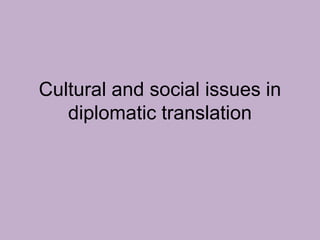
Diplomatic Presentation
- 1. Cultural and social issues in diplomatic translation
- 2. diplomacy involves constant interaction with members of other cultures When diplomatic translation takes place across languages and cultures the scope for misunderstanding increases
- 3. Diplomatic translation During the conference several speakers introduced categories and values which can be used to describe cultures and the way they communicate. (For example, ways of viewing time--monochronic vs. polychronic, past, present or future oriented; power distance; universalism vs. particularism; high and low context, etc.). diplomatic practice :Could specialists in intercultural communication propose the cultural categories or values they feel are most likely to affect diplomatic practice. Could diplomats provide some examples from their own experience where these cultural categories or values have affected their work and how they overcame the difficulties. What are the problems or difficulties associated with examining cultures in terms of categories? What are the benefits of this type of analysis?
- 4. Cross cultural in diplomatic translation Communication between Professional Cultures Sometimes the diplomat must translate between different professional cultures. For example, with negotiations on the environment, the diplomat must translate the language and logic of the environmentalists into language understandable to politicians, and vice versa. This task is sometimes more difficult than communication between different nations. When is translation between different professional cultures necessary? How can the diplomat prepare for this kind of intercultural communication?
- 5. Translation and Intercultural Communication At the same time as English has gained currency as an international language and as the most commonly used diplomatic language, many international organisations are recognising the various languages of member states as official or working languages for their proceedings, both oral and written. As a diplomat cannot learn an unlimited number of foreign languages, he or she must rely, to a large extent, on translators and interpreters. What are the difficulties or “pitfalls” in diplomatic translation and interpretation related to different cultural practices?Should training for translators and interpreters include intercultural communication as well as languages?
- 6. Interlingual communication It is obvious that in interlingual communication involving members of two different cultures this common knowledge may be seriously limited which will be an obstacle to understanding. In other words, the translated message is transferred not only to another language but also to another culture. This fact cannot but influence the translating process. In addition to overcoming the linguistic barrier the translator has to surmount the cultural barrier, to make sure that the receptors of the target text are provided with the presuppositions required for their access to the message con- tents.
- 7. Inter-Religious Communication Contact and communication between cultures often involves contact between religions, both between different religious communities within nations, and between nations. In many cases, religion is an essential part of the ethnic identity of a people, and as such is capable of contributing significantly to conflict or to peace. What are the difficulties or barriers to inter-religious communication? How can tolerance and cooperation between different religious communities be fostered in order to prevent or end conflict What are the benefits of better understanding, better communication and increased tolerance between different religious groups?
- 8. Migration and Minorities issues People migrate for a variety of reasons: as refugees, as recruited migrant workers, and as groups who find themselves as ethnic minorities when borders change. All of these situations involve contact and communication between different cultures: the host culture, already existing ethnic communities, and the new community, and the potential for misunderstanding, racism and ethnically based violence. These relations also affect the international relations of host countries with countries of origin, thus cause the issues in diplomatic translation.
- 9. To sum up: 1. The linguistic and cultural aspects of translation need not be opposed for they are complementary. Cultural (ethnographic) trans- lation problems can usually be reformulated as language problems and incorporated in the linguistic theory of translation.
- 10. Talks about the issue
